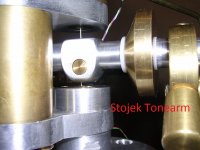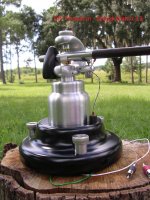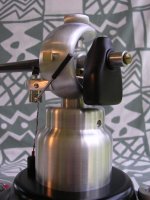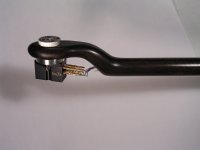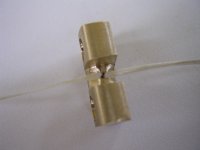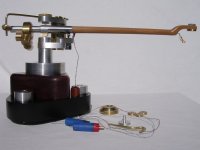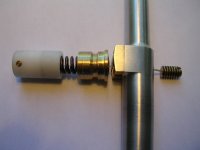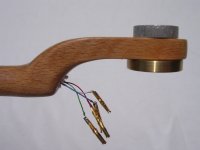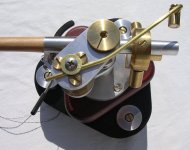.
Speaking of DIY linear tracking tonearm, here's a Japanese audiophile with some arms made of precision linear motion glides from THK:
???????????? IY Tonearm
IY Tonearm
https://tech.thk.com/en/products/pdf/en_a5_002.pdf#1
.
Speaking of DIY linear tracking tonearm, here's a Japanese audiophile with some arms made of precision linear motion glides from THK:
????????????
https://tech.thk.com/en/products/pdf/en_a5_002.pdf#1
.
I've been giving this whole string-driven-thing some thought (I'm going to have to make one). First consider the vertical "bearing". We have a horizontal tensioned string and suspend a mass (the arm) in the centre. If you remember your school physics and triangle of forces, that mass in the centre generates an enormous stretching force on the string. So the arm sags. Now imagine twisting the arm. The width of the arm across the string is not zero, so a balanced twisting force will attempt to further tension one side of the string, but untension the other side. That means that rather than twisting nicely, it will lift its pivot point and lose tension. Not nice. The effect will be proportional to the sag in the string. The obvious solution is to add more tension. But we can also keep the arm's total mass low.
Minimising an arm's total mass is unconventional. Conventional wisdom is to make the counterweight as heavy as possible in order to minimise its distance from the pivot and minimise its moment of inertia. It looks as though a string arm ought to have a light counterweight a long way away, and hang the effect on effective mass. If we're forced to accept higher-than-usual effective mass, then which cartridge would suit? We'd be looking at a low compliance cartridge that needs high mass. Step forward the Denon DL103. (Gosh, what a surprise, that's just what I have that needs an arm.)
It strikes me that another strength of the string-driven-thing is that it's "bearings" won't rattle. And which cartridges provoke bearing rattle? Low compliance ones. Like the Denon DL103.
This all looks like being a winner. We want an arm beam that doesn't weigh much and is nicely damped (wood looks good) and a light counterweight a long way away. This will make a high effective mass arm with minimum twist problems that will ideally suit a low compliance cartridge. Might as well make it 12" while we're at it...
Minimising an arm's total mass is unconventional. Conventional wisdom is to make the counterweight as heavy as possible in order to minimise its distance from the pivot and minimise its moment of inertia. It looks as though a string arm ought to have a light counterweight a long way away, and hang the effect on effective mass. If we're forced to accept higher-than-usual effective mass, then which cartridge would suit? We'd be looking at a low compliance cartridge that needs high mass. Step forward the Denon DL103. (Gosh, what a surprise, that's just what I have that needs an arm.)
It strikes me that another strength of the string-driven-thing is that it's "bearings" won't rattle. And which cartridges provoke bearing rattle? Low compliance ones. Like the Denon DL103.
This all looks like being a winner. We want an arm beam that doesn't weigh much and is nicely damped (wood looks good) and a light counterweight a long way away. This will make a high effective mass arm with minimum twist problems that will ideally suit a low compliance cartridge. Might as well make it 12" while we're at it...
You're very kind, thank you. I've been thinking about how I might make this arm, and the main problem seems to be avoiding "design creep". You know, where you start off with a simple idea for cutting two scraps of wood with a hand saw and screwing them together to support a book shelf, but end up milling an aerospace spar out of a single block of 7000 grade aluminium. Very nice, but way over the top. Even so...
I think string tension is important - we want lots of it. So we need a shape that can provide that tension without deforming. That means a large (3" or so) ring.
I can't seem to make up my mind about the arm wand. One idea I favour is a 3/4" (no typo) diameter aluminium tube clad with 1/16" balsa followed by a layer of hardwood veneer to make it look nice. The balsa will damp the aluminium, and the veneer would make it a little more robust. On the other hand, a rectangular cross-section composite of balsa and hardwood would make mounting the cartridge easier, but probably be less rigid.
I think string tension is important - we want lots of it. So we need a shape that can provide that tension without deforming. That means a large (3" or so) ring.
I can't seem to make up my mind about the arm wand. One idea I favour is a 3/4" (no typo) diameter aluminium tube clad with 1/16" balsa followed by a layer of hardwood veneer to make it look nice. The balsa will damp the aluminium, and the veneer would make it a little more robust. On the other hand, a rectangular cross-section composite of balsa and hardwood would make mounting the cartridge easier, but probably be less rigid.
Marek left, but I, Edward took over his thread. Marek’ wife was editing his posts to correct language and contents but shi did not want Marek to waste time arguing with moron like directdriver. I do not have a secretary.
I asked moderators to delete controversial “schroederized” drawings and post misrepresenting my design, but nothing is happening so I have to address the issues from post 33.
“Before I saw your design I was thinking along the same line…”
“If I a may, let me articulate the essence of this design…”
Directdriver, you are incapable to think along same line even after you saw my design; you may not and can not articulate my design.
Small example:
“The top string is stabilized by gravity and the bottom string is tensioned by a spring or magnet.”
There is only one string! The tension above the wand is higher but the whole string is tensioned by the spring several times more than by gravity.
Edward
I asked moderators to delete controversial “schroederized” drawings and post misrepresenting my design, but nothing is happening so I have to address the issues from post 33.
“Before I saw your design I was thinking along the same line…”
“If I a may, let me articulate the essence of this design…”
Directdriver, you are incapable to think along same line even after you saw my design; you may not and can not articulate my design.
Small example:
“The top string is stabilized by gravity and the bottom string is tensioned by a spring or magnet.”
There is only one string! The tension above the wand is higher but the whole string is tensioned by the spring several times more than by gravity.
Edward
Edward,
I have already apologize for vandalizing the drawing and once again I will apologize for misrepresenting your idea. I am sorry. But please refrain from personal attacks. I will listen and learn from the sideline. I wish there's a way to delete those drawings but I am not allowed to edit those so all I can say is to simply ignore them. Please carry on with ideas, everyone.
directdriver
I have already apologize for vandalizing the drawing and once again I will apologize for misrepresenting your idea. I am sorry. But please refrain from personal attacks. I will listen and learn from the sideline. I wish there's a way to delete those drawings but I am not allowed to edit those so all I can say is to simply ignore them. Please carry on with ideas, everyone.
directdriver
Edward,
Glad to see you back. You've made some great contributions here and I hope you continue.
I've had to acknowledge there are more things to do around my house than build tonearms, but before that I increased the size of the monofilament and the way the arm is positioned in the ring. The larger monofilament allowed more tension - nice improvement. At first, the arm had slots at the top and bottom. The strings went through the slots and positioned the arm when under tension, but the arm could slide sideways and rotate. I drilled four holes in the arm which allow the string to be cross-lace through the arm - can't slide or rotate now and because everything is triangulated there's no sag. I can probably do something similar with the ring suspension to remove residual bounce there, but on the other hand, there's that "design creep" EC8010 mentions.
Pictures of the Schroeder model one with the two-string trapeze show a longer than usual end stub and a Denon DL103 on the business end.
I've found that shorter strings tighten faster in response to displacement than long ones so my choice is for the smallest possible ring in compatible with the arm diameter and the shortest possible distance from the ring to the frame. "Possible" includes being able to run the string easily, too. PVC schedule 40 plumbing pipe is cheap, easy to work with, strong, and has a low "ping" factor.
1/2" x1/2" U channel aluminum back-filled with balsa on the open side after the wires are laid in might work well, too.
What's this thing going to be called when all's said and done? "Spyder" of course.
Glad to see you back. You've made some great contributions here and I hope you continue.
I've had to acknowledge there are more things to do around my house than build tonearms, but before that I increased the size of the monofilament and the way the arm is positioned in the ring. The larger monofilament allowed more tension - nice improvement. At first, the arm had slots at the top and bottom. The strings went through the slots and positioned the arm when under tension, but the arm could slide sideways and rotate. I drilled four holes in the arm which allow the string to be cross-lace through the arm - can't slide or rotate now and because everything is triangulated there's no sag. I can probably do something similar with the ring suspension to remove residual bounce there, but on the other hand, there's that "design creep" EC8010 mentions.
Pictures of the Schroeder model one with the two-string trapeze show a longer than usual end stub and a Denon DL103 on the business end.
I've found that shorter strings tighten faster in response to displacement than long ones so my choice is for the smallest possible ring in compatible with the arm diameter and the shortest possible distance from the ring to the frame. "Possible" includes being able to run the string easily, too. PVC schedule 40 plumbing pipe is cheap, easy to work with, strong, and has a low "ping" factor.
1/2" x1/2" U channel aluminum back-filled with balsa on the open side after the wires are laid in might work well, too.
What's this thing going to be called when all's said and done? "Spyder" of course.
It does look lovely and the design is just great.
But question, I just can't see how allowing any freedom of movement, even for dampening, in the direction of drag on the record could be beneficial for the sound. What do you achieve by using a string suspension?
You should take a look at the Well Tempered "Amadeus" turntable for yet another example of a string suspended tonearm. It may have been mentioned before, so if that's the case, I apologize.
(Late Edit) OK, here it is:
An externally hosted image should be here but it was not working when we last tested it.
Best Regards,
TerryO
Last edited:
its an elegant design, but it seems counter intuitive. Uni pivot makes a lot more sense to me. What are the overall differences between a more rigid coupling and a string?
The Amadeus actually has two attachment points, one on each side of the Golf Ball, with the twist in the supporting monofilament provides the arm's anti-skating. I would say that the most obvious difference from a Unipivot would be the total lack of transmitted vibration to the tone arm at the pivot.
In this case, there are enough owners that can tell you if it actually works, in case you want to skip all the reviews.
Best Regards,
TerryO
Hi Tade,
You are right, freedom of movement in direction of drag as well as changes of drag caused by changes of VTF mess up the sound. The fine example of that is WT - its sound is described in post #22.
In my tonearm drag changes are very small. They are practically limited to changes caused by changing modulation of the groove. So my tonearm has not much reason to move back and forth. The tension of my string is a few kilograms so my tonearm has not much freedom in that direction either. Also, to limit horizontal movement and vibration of the string, the string passes through a small hole drilled in the base. The hole is located just under the wand.
When tonearm is suspended by string, changes of VTF caused by cartridge moving up and down when playing wavy record can be big and consequently changes of drag can also be big. I calculated those forces and designed the pivot accordingly. The picture shows how my string exits part of the wand – diameter of the hole is only 0.8mm, so the bearing acts almost like a conventional unipivot but without the wobbling.
Below is my simplified formula I figured out to calculate springing reaction of beam (wand) suspended on tensioned string:
VTF change=x *h* F /L^2
x - Vertical travel of headshell
h - Vertical distance between upper and lower suspension points – in my tonearm it is about 1.5 mm.
F - Tension of the string
L - Effective length of a tonearm
I have used same equation to calculate geometry of Schroeder clone. My formula is not good for WT tonearm as viscosity of oil can make things much worse than wrong geometry of the bearing does.
What did I achieve? Sound waves induced by vibrating stylus travel in the wand and return to cartridge generator distorting generated signal. My tensioned string drains sound waves out of the wand more efficiently than needle point does. Needle point may look like a rigid coupling but it forms acoustic barrier. The sound of my tonearm is cleaner, more detailed, natural and more dynamic than conventional commercial unipivot I have tried.
I hope this answers your questions. More info is in my posts.
Marek
You are right, freedom of movement in direction of drag as well as changes of drag caused by changes of VTF mess up the sound. The fine example of that is WT - its sound is described in post #22.
In my tonearm drag changes are very small. They are practically limited to changes caused by changing modulation of the groove. So my tonearm has not much reason to move back and forth. The tension of my string is a few kilograms so my tonearm has not much freedom in that direction either. Also, to limit horizontal movement and vibration of the string, the string passes through a small hole drilled in the base. The hole is located just under the wand.
When tonearm is suspended by string, changes of VTF caused by cartridge moving up and down when playing wavy record can be big and consequently changes of drag can also be big. I calculated those forces and designed the pivot accordingly. The picture shows how my string exits part of the wand – diameter of the hole is only 0.8mm, so the bearing acts almost like a conventional unipivot but without the wobbling.
Below is my simplified formula I figured out to calculate springing reaction of beam (wand) suspended on tensioned string:
VTF change=x *h* F /L^2
x - Vertical travel of headshell
h - Vertical distance between upper and lower suspension points – in my tonearm it is about 1.5 mm.
F - Tension of the string
L - Effective length of a tonearm
I have used same equation to calculate geometry of Schroeder clone. My formula is not good for WT tonearm as viscosity of oil can make things much worse than wrong geometry of the bearing does.
What did I achieve? Sound waves induced by vibrating stylus travel in the wand and return to cartridge generator distorting generated signal. My tensioned string drains sound waves out of the wand more efficiently than needle point does. Needle point may look like a rigid coupling but it forms acoustic barrier. The sound of my tonearm is cleaner, more detailed, natural and more dynamic than conventional commercial unipivot I have tried.
I hope this answers your questions. More info is in my posts.
Marek
Attachments
- Status
- This old topic is closed. If you want to reopen this topic, contact a moderator using the "Report Post" button.
- Home
- Source & Line
- Analogue Source
- DIY tensioned string suspended tonearm
